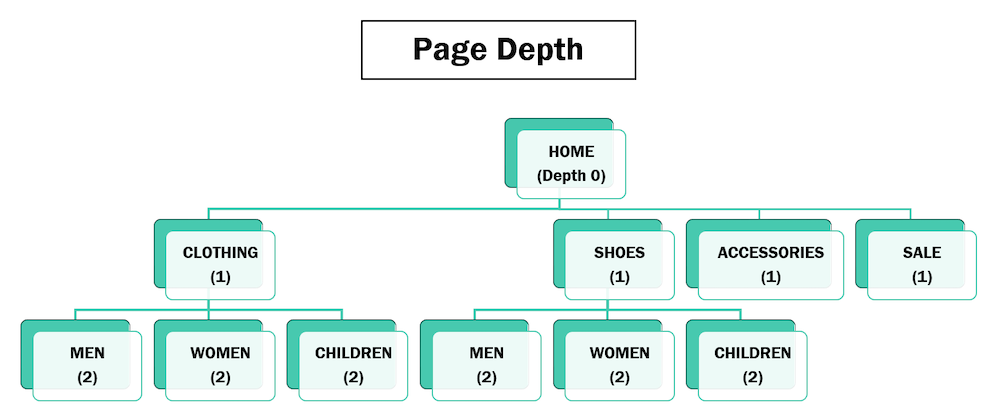The number of clicks it takes to go from the homepage to another page within a website is called click depth and is an important factor that many people often neglect. There have been numerous questions regarding the importance of click depth. This article will help you know more about click depth and whether or not it can affect search engine rankings.
What Is Click Depth?
Click depth, also known as page depth, can be described as the number of clicks it takes a user to go from the home page to another page within the website. The links that take you to other pages within the website are called internal links, and they are an important factor in how a website ranks in the search results. A website’s click-depth can help Google understand more about it and can also affect its rankings in the search results.
This is how page depth works: the home page is assigned the value of 0. Any page that is linked to the home page will be assigned as 1. Similarly, pages linked within page 1 will be assigned as 2. The click depth value can be identified by assigning numerical values to the pages linked on the website.
How does this help, you may ask? According to John Mueller at Google, it places attention on how many links the home page of a website has and the number of clicks it takes to go to other pages.

Example For Click-depth
A simple example of click depth would be
1. The homepage
2. The first click – Comic books
3. The second click- DC comic books
4. The third click- Batman comics
5. The fourth click- “The Killing Joke”
Note that the number of clicks it takes to go to the desired page should not exceed three. The Google bots will not crawl anything more than that.
Is Click Depth a Ranking Factor In Google?
Sometimes when you are on the homepage, it takes multiple clicks to go to the desired page. This is a problem because search engine crawlers will stop browsing a website if it takes more than 3 clicks to go to other pages. The only exception is for pages that have higher authority (such as the home page).
Google uses a page rank algorithm to determine the quality of a website. The algorithm checks the number of pages and their quality to do so. The best option would be to link top-performing (most views) pages in the front. The reason why is that on most websites, the home page holds more weight and has a higher authority when compared to other pages on the website.
If a website has poor click depth, it can hurt search results. If the pages are linked far away from the homepage (more than 3 clicks), the crawler bot will not browse through them. This means the pages will not reach the indexing process by crawler bots.
What Type Of URL Structure Is Best For Page Depth?
The best type of URL structure is the one where the categories are clearly defined and help potential customers get where they want to quickly. When creating sub-pages, you can customise the URL structure so that when a user clicks on a link on the homepage, they will be redirected to the target page. By doing so, you will be able to create structured content that includes subcategories.
For example, if the website is about books, the URL of the homepage would be “st.marybookstore.com,” and the subcategory would be “www.st.marybookstore.com/novels/fiction.”
Is Internal Linking An Important Part Of SEO?
When ranking, Google identifies internal links as an important factor. Whether it is a blog post or a video, internal linking is a must-have. It has more weight in the search results than page depth. This doesn’t mean that page depth is irrelevant. Many people often overlook the importance of click depth.
What To Do If a Website Has Multiple Pages
In some cases, websites have numerous pages. Big stores even have more than 50000 pages. In such cases, how would one link all the pages so that Google’s crawler bots can easily navigate with only a few clicks? The solution to this problem is the midpoint link pagination scheme.
In a midpoint link pagination scheme, the page links are kept short by keeping a middle point in between the numbers. For example, If there are 200 pages, the links would look like this; 1, 2, 3……100,……200.
This way, search engine crawlers can easily browse through the pages.
Specialist article: Email Marketing Made Simple: A step-by-step guide with examples
Best Practices To Improve Click Depth Issues
If your website has poor click depth, you can improve it by following the given tips. To make your site more accessible to crawlers, you must:
1. Add Internal Links
Use internal links within the text to make them seem more natural. It also makes it easier for the user and the crawler to reach the linked page in just a few steps.
2. Increase high-level categories
Keep high-level categories of pages closer to the homepage. This means the number of clicks it takes to get to high-level categories on the website must be low.
3. Reduce The Pagination
Keep the pagination links to a minimum of five. If too many pagination links exist, it will be difficult for the crawler to browse through them.
4. Increase The Site Speed
By increasing the site speed, you can reduce the time it takes for the crawl bot to browse. This will enable them to browse through the links quickly.
5. Fix any 404 errors and redirect
By fixing the 404 errors and redirects, you will be able to eliminate the chances of the Google bot slowing down. You can make the browsing process smoother by fixing these issues.
6. Take relevant content from low-depth pages
When linking content to the website, take pages that have low-depth value.
Specialist Article: Hyper-Personalisation Strategies to Drive Ecommerce KPIs
Click Depth Is Important
Click depth is an important part of a website, and it needs more attention. They are essential for crawlers to browse through and determine the quality of a website. So, make sure to give click depth a good amount of research and time to get the most out of your website.





